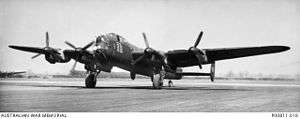No. 576 Squadron RAF
| No. 576 Squadron RAF | |
|---|---|
|
576 Squadron Avro Lancaster at RAF Fiskerton, 1945 | |
| Active | 25 Nov 1943 – 13 Sep 1945 |
| Country |
|
| Branch |
|
| Role | Bomber squadron |
| Part of | No. 1 Group, RAF Bomber Command[1] |
| Motto(s) |
Latin: Carpe Diem (Translation: "Seize the opportunity" or "Pluck the day")[2][3] |
| Insignia | |
| Squadron Badge heraldry |
A merlin, wings inverted and addorsed, preying on a serpent[3] The squadron had its aircraft fitted with Merlin engines and the badge is symbolic of the unit seeking out and destroying its prey[2] |
| Squadron Codes | UL (Nov 1943 – Sep 1945)[4][5] |
| Aircraft flown | |
| Bomber |
Avro Lancaster Four-engined heavy bomber |
No. 576 Squadron RAF was a Royal Air Force Second World War heavy bomber squadron.
History
No. 576 Squadron was formed on 25 November 1943 from 'C' Flight of 103 squadron at RAF Elsham Wolds in Lincolnshire. It started operations in the night of 2/3 December 1943, when seven Avro Lancasters were sent out to bomb Berlin.[6] Eleven months later 576 Squadron moved to RAF Fiskerton, a little way outside Lincoln. During its brief period of existence 576 Squadron operated only one type of aircraft, the Avro Lancaster four-engined heavy bomber. It carried out 2,788 operation sorties with the Lancaster, with the loss of 66 aircraft.[7] The last bombs of the squadron were dropped on 25 April 1945, when 23 of the squadrons aircraft bombed Berchtesgaden; its last operational mission was a food dropping to the starving Dutch people in Rotterdam on 7 May 1945.[6] 576 Squadron was disbanded at Fiskerton on 13 September 1945.
Aircraft operated
| From | To | Aircraft | Version |
|---|---|---|---|
| November 1943 | September 1945 | Avro Lancaster | Mks.I, III |
Notable aircraft
Four of the Lancasters that flew with 576 squadron managed to survive one hundred operations or more:
| Serial no. | Name | Operations | Call-sign | Fate | Remarks |
|---|---|---|---|---|---|
| ED888 | "Mike Squared" | 140 | UL-V2, UL-M2 | Struck off charge, 8 January 1947 | Flew 140 missions in total, initially with No. 103 Squadron RAF from April 1943, and then with 576 Squadron[10][11] |
| ME801 | "Nan" | 114 | UL-C2, UL-N2 | Struck off charge, 16 October 1945 | [12] |
| LM594 | "A Able" | 104 | UL-G2, UL-A2 | Struck off charge, 13 February 1947 | [13] |
| LM227 | "Item" | 100 | UL-I2 | Struck off charge, 16 October 1945 | [14] |
Squadron bases
| From | To | Base |
|---|---|---|
| 25 November 1943 | 31 October 1944 | RAF Elsham Wolds, Lincolnshire |
| 31 October 1944 | 13 September 1945 | RAF Fiskerton, Lincolnshire |
References
Notes
- ↑ Delve 1994, pp. 68, 77.
- 1 2 Moyes 1976, p. 269.
- 1 2 3 4 Halley 1988, p. 413.
- ↑ Bowyer and Rawlings 1979, p. 101.
- ↑ Flintham and Thomas 2003, p. 109.
- 1 2 3 Moyes 1976, p. 270.
- ↑ Falconer 2003, p. 256.
- 1 2 Jefford 2001, p. 98.
- ↑ Moyes 1976, p. 362.
- ↑ "ED888 'Mother'/'Mike Squared'". Build the Lancaster. Hachette Partworks. 2011.
- ↑ Franks 1994, pp. 72–78.
- ↑ Franks 1994, pp. 154–158.
- ↑ Franks 1994, pp. 141–144.
- ↑ Franks 1994, pp. 130–134.
- ↑ Moyes 1976, pp. 269–270.
Bibliography
- Bowyer, Michael J.F.; John D.R. Rawlings (1979). Squadron Codes, 1937–56. Cambridge, UK: Patrick Stephens Ltd. ISBN 0-85059-364-6.
- Delve, Ken (1994). The Source Book of the RAF. Shrewsbury, Shropshire, UK: Airlife Publishing. ISBN 1-85310-451-5.
- Flintham, Vic; Andrew Thomas (2003). Combat Codes: A full explanation and listing of British, Commonwealth and Allied air force unit codes since 1938. Shrewsbury, Shropshire, UK: Airlife Publishing Ltd. ISBN 1-84037-281-8.
- Franks, Norman (1994). Claims to Fame: The Lancaster. London: Arms and Armour Press. ISBN 1-85409-220-0.
- Halley, James J. (1988). The Squadrons of the Royal Air Force & Commonwealth, 1918–1988. Tonbridge, Kent, UK: Air-Britain (Historians) Ltd. ISBN 0-85130-164-9.
- Falconer, Jonathan (2003). Bomber Command Handbook 1939–1945. Stroud, England: Sutton Publishing. ISBN 0-7509-3171-X.
- Jefford, Wing Commander C.G. (2001). RAF Squadrons, a Comprehensive record of the Movement and Equipment of all RAF Squadrons and their Antecedents since 1912. Shrewsbury, Shropshire, UK: Airlife Publishing Ltd. ISBN 1-85310-053-6.
- Moyes, Philip J.R. (1976). Bomber Squadrons of the RAF and their Aircraft. London: Macdonald and Jane's (Publishers) Ltd. ISBN 0-354-01027-1.
External links
| Wikimedia Commons has media related to No. 576 Squadron RAF. |
- 576 squadron history on old MOD site
- Squadron histories for nos. 541–598 sqn on RafWeb's Air of Authority – A History of RAF Organisation

